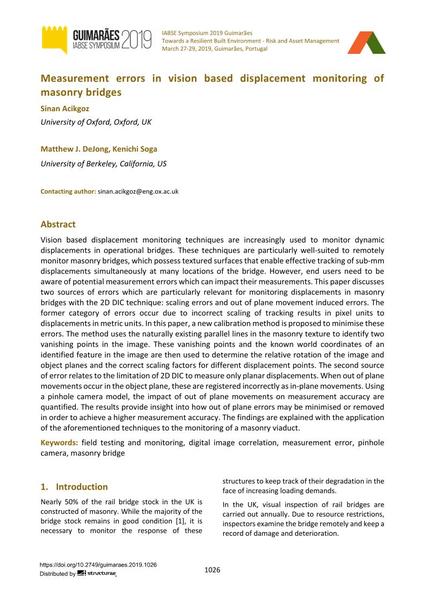Measurement errors in vision based displacement monitoring of masonry bridges

|
|
|||||||||||
Bibliographic Details
| Author(s): |
Sinan Acikgoz
(University of Oxford, Oxford, UK)
Matthew J. DeJong (University of Berkeley, California, US) Kenichi Soga (University of Berkeley, California, US) |
||||
|---|---|---|---|---|---|
| Medium: | conference paper | ||||
| Language(s): | English | ||||
| Conference: | IABSE Symposium: Towards a Resilient Built Environment Risk and Asset Management, Guimarães, Portugal, 27-29 March 2019 | ||||
| Published in: | IABSE Symposium Guimarães 2019 | ||||
|
|||||
| Page(s): | 1026-1033 | ||||
| Total no. of pages: | 8 | ||||
| DOI: | 10.2749/guimaraes.2019.1026 | ||||
| Abstract: |
Vision based displacement monitoring techniques are increasingly used to monitor dynamic displacements in operational bridges. These techniques are particularly well-suited to remotely monitor masonry bridges, which possess textured surfaces that enable effective tracking of sub-mm displacements simultaneously at many locations of the bridge. However, end users need to be aware of potential measurement errors which can impact their measurements. This paper discusses two sources of errors which are particularly relevant for monitoring displacements in masonry bridges with the 2D DIC technique: scaling errors and out of plane movement induced errors. The former category of errors occur due to incorrect scaling of tracking results in pixel units to displacements in metric units. In this paper, a new calibration method is proposed to minimise these errors. The method uses the naturally existing parallel lines in the masonry texture to identify two vanishing points in the image. These vanishing points and the known world coordinates of an identified feature in the image are then used to determine the relative rotation of the image and object planes and the correct scaling factors for different displacement points. The second source of error relates to the limitation of 2D DIC to measure only planar displacements. When out of plane movements occur in the object plane, these are registered incorrectly as in-plane movements. Using a pinhole camera model, the impact of out of plane movements on measurement accuracy are quantified. The results provide insight into how out of plane errors may be minimised or removed in order to achieve a higher measurement accuracy. The findings are explained with the application of the aforementioned techniques to the monitoring of a masonry viaduct. |
||||
| Keywords: |
masonry bridge digital image correlation field testing and monitoring measurement error pinhole camera
|
||||
